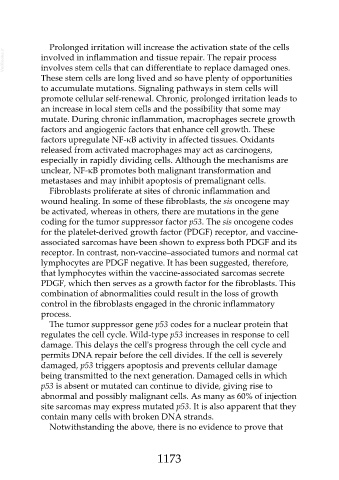Page 1173 - Veterinary Immunology, 10th Edition
P. 1173
Prolonged irritation will increase the activation state of the cells
VetBooks.ir involved in inflammation and tissue repair. The repair process
involves stem cells that can differentiate to replace damaged ones.
These stem cells are long lived and so have plenty of opportunities
to accumulate mutations. Signaling pathways in stem cells will
promote cellular self-renewal. Chronic, prolonged irritation leads to
an increase in local stem cells and the possibility that some may
mutate. During chronic inflammation, macrophages secrete growth
factors and angiogenic factors that enhance cell growth. These
factors upregulate NF-κB activity in affected tissues. Oxidants
released from activated macrophages may act as carcinogens,
especially in rapidly dividing cells. Although the mechanisms are
unclear, NF-κB promotes both malignant transformation and
metastases and may inhibit apoptosis of premalignant cells.
Fibroblasts proliferate at sites of chronic inflammation and
wound healing. In some of these fibroblasts, the sis oncogene may
be activated, whereas in others, there are mutations in the gene
coding for the tumor suppressor factor p53. The sis oncogene codes
for the platelet-derived growth factor (PDGF) receptor, and vaccine-
associated sarcomas have been shown to express both PDGF and its
receptor. In contrast, non-vaccine–associated tumors and normal cat
lymphocytes are PDGF negative. It has been suggested, therefore,
that lymphocytes within the vaccine-associated sarcomas secrete
PDGF, which then serves as a growth factor for the fibroblasts. This
combination of abnormalities could result in the loss of growth
control in the fibroblasts engaged in the chronic inflammatory
process.
The tumor suppressor gene p53 codes for a nuclear protein that
regulates the cell cycle. Wild-type p53 increases in response to cell
damage. This delays the cell's progress through the cell cycle and
permits DNA repair before the cell divides. If the cell is severely
damaged, p53 triggers apoptosis and prevents cellular damage
being transmitted to the next generation. Damaged cells in which
p53 is absent or mutated can continue to divide, giving rise to
abnormal and possibly malignant cells. As many as 60% of injection
site sarcomas may express mutated p53. It is also apparent that they
contain many cells with broken DNA strands.
Notwithstanding the above, there is no evidence to prove that
1173

